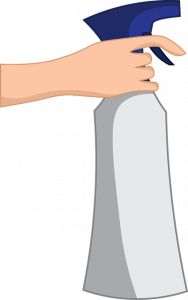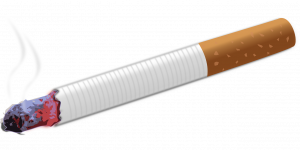Chronic inflammation and your pet – part 2

When free radicals are released from cells undergoing oxidative stress, the result is chronic inflammation and a variety of health problems in dogs and cats.
In the first part of this article, we looked at the connection between chronic inflammation and obesity, and how keeping your dog or cat at a healthy weight can reduce inflammation in his body. Here, we’ll look at the connection between chronic inflammation and cancer, and how dietary changes can help.
Cancer is responsible for about half of all dog and cat deaths in North America. Mounting evidence links cancer to environmental toxins – everything from common household cleaners and pesticides to flea and tick preventives and vaccines have been shown to cause carcinogenic mutations. In fact, researchers estimate that only 5% to 10% of all cancer cases originate from genetic predisposition, while 90% to 95% are the result of lifestyle and environmental factors. They have even concluded that 30% to 40% of all cancers can be prevented by implementing dietary changes. This is good news for our cats and dogs.
Inflammation and cancer – 9 predisposing factors
1. Obesity alters the metabolism of hormones that maintain and control the balance of cell proliferation, maturation and cell death. Pro-inflammatory mediators, like cytokines produced by fat cells, activate a factor that promotes carcinogenic change. Fifteen types of cancer in people are linked to long-term obesity, especially the bowel cancer that occurs later in life.
2. High glycemic index (GI) carbs promote cancer mutations as well as high levels of insulin. This results in a high risk for type 2 diabetes and colorectal cancer. One should avoid eating and feeding refined sugars and flours.
3. Fluoride accumulates in bones, causing a high risk for bone cancer (osteosarcoma). Dogs are ten times more likely to have osteosarcoma than people. High fluoride levels are found in food and fluoridated water. As well, commercial dry dog foods contain 1.6 to 2.5 times the safe fluoride level stated by the EPA because these foods typically contain bone meal, meat meal and meat by-product meal. Dogs with cancer should avoid bone meal and animal by-products, and drink fluoride-free water.
 4. Environmental toxins include lawn and garden pesticides, herbicides, fertilizers, swimming pool products, household cleaning, carpet and laundry products, construction materials, automotive products including antifreeze batteries and battery acids, personal care and hygiene products, pet care and grooming products.
4. Environmental toxins include lawn and garden pesticides, herbicides, fertilizers, swimming pool products, household cleaning, carpet and laundry products, construction materials, automotive products including antifreeze batteries and battery acids, personal care and hygiene products, pet care and grooming products.
5. PBDEs (PolyBrominated Diphenyl Ethers) are flame-retardant chemicals that have been used in clothing, furniture and electronics for 40 years. They leak into the environment and are known disruptors of endocrine function, especially of the thyroid gland. They have also been linked to developmental problems, and even cancer, in animals.
Residues of PBDEs are found in the serum, foods and house dust of cats and dogs. PBDE levels in cats can be 20 to 100 times those found in humans, while levels in dogs are five to ten times higher; dogs metabolize them faster than cats, and have an enzyme that helps detoxify them.

6. Secondhand smoke is a serious culprit. Research studies have found that dogs exposed to large amounts of secondhand smoke eventually show pre-cancerous changes and even cancerous lesions in their lung tissue.
7. Topical flea/tick preventives are another issue. In 1989, Purdue University Veterinary School found that dogs receiving one or two topical pesticides per year had a 60% increased risk of bladder cancer. Dogs given more than two applications per year were 3.5 times more likely to develop bladder cancer. The risk was increased even more in overweight or obese dogs.
8. Adverse vaccine reactions are common. Both MLV and inactivated killed vaccines can produce serious adverse reactions, including death, in susceptible animals. Injection site sarcomas can occur in both dogs and cats, and can reoccur after removal. These lesions are most commonly associated with rabies and feline leukemia vaccines, but can occur after any vaccination. Affected pets should not be revaccinated, including for rabies. These pets need to receive written exemption/waivers instead.
9. Bispenol-A (BPA) is a chemical used to harden plastics and resins while keeping them flexible. Despite its known health hazards, it is still used in plastic water bottles, food containers, and to line food tins. BPA leaches into the food and beverages it comes into contact with, which means an estimated 95% of the population has BPA exposure. It has estrogen-like properties and affects many body tissues and functions. Please only use canned goods that are labelled BPA-, BPF- and BPS-free.
As you can see, many things contribute to chronic inflammation in your pet’s body. And over time, that inflammation can lead to cancer. Being aware of the predisposing factors and taking steps to eliminate or minimize their effects, along with feeding your dog or cat a healthy diet, can reduce his risk of inflammation and cancer.
Foods, nutrients and supplements that fight inflammation and cancer
- Dietary changes can prevent 30% to 40% of all cancers. Remove harmful foods that block the effects of functional foods. Functional foods and nutrients include turmeric (curcumin), folate, cruciferous vegetables, SAMe, vitamin B12, green leafy and yellow orange vegetables, ginger, milk thistle, berries (blueberries, cranberries, chokeberries), pomegranate, medicinal mushrooms, prebiotics (spirulina), and probiotics, vitamin D and Omega-3 fatty acids.
- Antioxidants help balance the immune system and reduce free radical damage. They include vitamins A, C, E and co-enzyme Q10. Antiangiogenic supplements such as pectin and shark cartilage help reduce the blood supply to cancers.
- Beneficial phytochemicals include carotenoids (e.g. beta-carotene, lutein), flavonoids (e.g. quercetin, resveratrol, rutin), and phytosterols (plant sterols). Use green leafy vegetables like spinach, broccoli, kale, lettuce, Italian parsley, Swiss chard, collards, bok choy or turnip greens. Add yellow orange vegetables like squashes, carrots, pumpkin, yellow beets, yams, and sweet potatoes. Both green leafy and yellow orange vegetables, when given three times a week or more, can decrease canine bladder cancer risk by 92%.
Oxidative stress, chronic inflammation and cancer – main contributors
1. Oxidative stress
Canine patients with lymphoma, fibrosarcoma, mast cell tumor, malignant melanoma, osteosarcoma, nasal and other tumors were studied and compared to healthy dogs. Results showed a significant increase in antioxidant capacity and activity in the cancer group, along with impaired defense mechanisms.
2. Cancer and immune surveillance
Cancer cells are created in the body every day. A healthy immune system distinguishes these altered cells from normal cells and kills them. However, when the immune system is compromised, these cells live and divide until they create tumors. Cancer cells are energy-hungry and use glucose and protein for energy; they prefer certain amino acids, like arginine, and use it the expense of the host. Thus, cancer diets often contain arginine to replenish and repair depleted sources.
3. Behavior of cancer cells
Cancer cells preferentially metabolize glucose for energy. This differs from normal cells as cancer cells form lactate, an acid that causes the body to expend energy to convert it back to glucose. Cancer diets should thus be low in carbohydrates, although end-stage cancer diets include carbohydrates to replace the body’s depleted energy stores.
Most cancer cells cannot metabolize fats, so cancer diets also need high quality, high fat content (especially Omega-3 fatty acids) to provide a safe energy source. However, these high fat diets are unsuitable for pets prone to pancreatitis or liver disease. Bioavailable vitamins and minerals are also needed.



